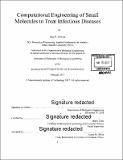| dc.contributor.advisor | Bruce Tidor. | en_US |
| dc.contributor.author | Srinivas, Raja R | en_US |
| dc.contributor.other | Massachusetts Institute of Technology. Department of Biological Engineering. | en_US |
| dc.date.accessioned | 2017-06-06T19:24:21Z | |
| dc.date.available | 2017-06-06T19:24:21Z | |
| dc.date.copyright | 2017 | en_US |
| dc.date.issued | 2017 | en_US |
| dc.identifier.uri | http://hdl.handle.net/1721.1/109667 | |
| dc.description | Thesis: Ph. D., Massachusetts Institute of Technology, Department of Biological Engineering, 2017. | en_US |
| dc.description | Page 193 blank. Cataloged from PDF version of thesis. | en_US |
| dc.description | Includes bibliographical references (pages 185-192). | en_US |
| dc.description.abstract | Rational drug design of small molecules has led to the development of robust therapeutics that are currently used in the clinic. However, key challenges remain in designing drugs against infectious disease targets that are susceptible to mutation. To achieve full clinical efficacy against rapidly-mutating targets, new methods must be developed for designing drugs. In this thesis, we utilize a three pronged approach for rational ligand design by developing methods, analyzing existing experimental data, and designing novel therapeutics. On-target mutations in infectious diseases often render inhibitors ineffective and are one of the key clinical failures of current therapies. We use HIV protease as a model system to understand mutation resistance. HIV protease substrates are unaffected or only moderately affected by resistance mutations that greatly decrease inhibitor binding. This idea has led to the design of broadly binding inhibitors using substrate mimicry. This is achieved by constraining inhibitors to bind within the consensus substrate volume, which we term the "substrate envelope". However, while the substrate envelope has been relatively successful, some inhibitors that are designed based on this model are sensitive to mutants. We performed a detailed biophysical binding energy decomposition of a flat and susceptible binder pair and found that the susceptible inhibitor forms stronger interactions with key residues. These residues are entirely characterized by examining known resistant mutants to approved HIV protease inhibitors. To generalize our findings, we cross-validate on a set of ten HIV protease inhibitors with previously measured sensitivity. We find that interaction energy successfully classifies susceptible and flat inhibitors. Based on these results, we extend the current design paradigm. We develop a methodology to minimize extraneous contacts with the active site and express it as an appropriate cost function, which is then minimized. We then implement this design scheme for HIV protease, yielding both flat and susceptible binders. Next, we apply rational drug design principles to other infectious disease targets. We first focus on the tuberculosis specific CIpP1P2 peptidase to optimize the antibiotic, acyl depsipeptides (ADEPs). We use component analysis to understand the biophysics of ADEP binding to the active site. We then design a series of analogs resulting in a two-fold affinity improvement along with enhanced peptidase activity. We also develop new methods to improve an anti-fungal for the treatment of Candida albicans. We use molecular docking to predict a binding mode for the lead compound and then account for receptor plasticity by performing molecular dynamics simulations. We use this improved receptor model to design novel analogs that are predicted to bind better than the parent compound. Lastly, we focus on disease diagnosis by developing a novel paradigm for MRI contrast agent design. We first integrate the governing thermodynamics and relevant parameters that influence imaging efficacy to develop an integrated workflow for contrast agent design. We then apply our methodology to the DOTA system and successfully explain differential activity of designed analogs. Put together, we demonstrate the power of rational design in various relevant biological contexts. Overall, this thesis presents new techniques, analysis, and applications of rational design to address unmet clinical problems. Work from this thesis accelerates the field of computational drug design, which has implications in many uncured diseases and diagnostics. | en_US |
| dc.description.statementofresponsibility | by Raja R. Srinivas. | en_US |
| dc.format.extent | 193 pages | en_US |
| dc.language.iso | eng | en_US |
| dc.publisher | Massachusetts Institute of Technology | en_US |
| dc.rights | MIT theses are protected by copyright. They may be viewed, downloaded, or printed from this source but further reproduction or distribution in any format is prohibited without written permission. | en_US |
| dc.rights.uri | http://dspace.mit.edu/handle/1721.1/7582 | en_US |
| dc.subject | Biological Engineering. | en_US |
| dc.title | Computational engineering of small molecules to treat infectious diseases | en_US |
| dc.type | Thesis | en_US |
| dc.description.degree | Ph. D. | en_US |
| dc.contributor.department | Massachusetts Institute of Technology. Department of Biological Engineering | |
| dc.identifier.oclc | 988344508 | en_US |
